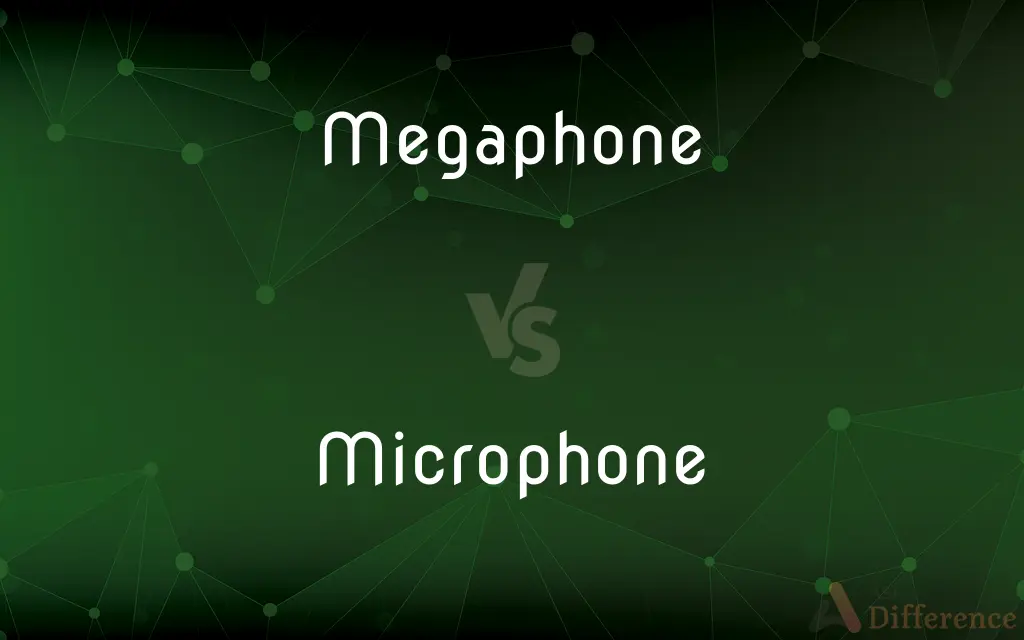Megaphone vs. Microphone — What's the Difference?
By Maham Liaqat & Urooj Arif — Updated on March 28, 2024
A megaphone amplifies voice across distances without electricity, while a microphone converts sound into electrical signals for amplification or recording.

Difference Between Megaphone and Microphone
Table of Contents
ADVERTISEMENT
Key Differences
A megaphone, often used in outdoor events, protests, or in situations where one needs to be heard over a distance, works by mechanically amplifying the sound of the voice through a cone-shaped tube. It directs and increases the sound waves' reach without the need for electrical power, making it highly portable and easy to use in various settings. On the other hand, a microphone is a device that captures sound and converts it into electrical signals. These signals can then be amplified, recorded, or transmitted over distances, requiring an external power source or system, such as a speaker or recording device, to function effectively.
Megaphones are simple in design and function, focusing on immediate voice amplification for live audiences. They are especially useful in scenarios where electricity is unavailable or impractical. Microphones, however, offer versatility in their application, from recording studios and live performances to telecommunications, where sound quality, modulation, and control are paramount. They can capture a wide range of sounds, from the human voice to musical instruments, and are integral to modern sound engineering and broadcasting.
While a megaphone is primarily a one-way communication tool designed to project sound from one source to a larger audience, microphones can be part of complex systems that allow for two-way communication, such as in telephones or intercom systems. Moreover, microphones are essential in the production of digital media, enabling the creation and manipulation of sound in post-production processes.
The choice between a megaphone and a microphone depends on the context of use. A megaphone is suitable for direct voice amplification in outdoor, informal, or emergency situations, offering simplicity and ease of use. A microphone, however, is suited for scenarios requiring sound capture, quality, and versatility, playing a crucial role in entertainment, communication, and information technology.
Comparison Chart
Function
Amplifies voice mechanically for live audiences.
Converts sound into electrical signals for various uses.
ADVERTISEMENT
Power
Does not require electricity.
Requires an external power source for operation.
Use Cases
Outdoor events, protests, situations without access to power.
Recording, broadcasting, live performances, communication.
Design
Simple, cone-shaped for directing sound.
Varied designs to capture different types of sound.
Communication
Primarily one-way, from speaker to audience.
Can facilitate both one-way and two-way communication.
Compare with Definitions
Megaphone
Mechanical voice amplification.
The coach used a megaphone to give instructions across the field.
Microphone
Converts sound to electrical signals.
The singer's voice was captured clearly by the studio microphone.
Megaphone
Directs sound to reach a wider area.
Tour guides often use megaphones to speak to large groups in noisy environments.
Microphone
Used in a wide range of applications.
Podcasters rely on high-quality microphones for clear audio recordings.
Megaphone
Ideal for outdoor or emergency use.
The lifeguard had a megaphone ready for emergency announcements at the beach.
Microphone
Integral to modern communication and media.
News anchors use lapel microphones for hands-free speaking on air.
Megaphone
Portable and easy to use.
During the rally, speakers used megaphones to address the crowd.
Microphone
Requires external power for operation.
Before the performance, they checked all the microphones were properly connected to the sound system.
Megaphone
Does not require electrical power.
In the blackout, the community leader used a megaphone to communicate with residents.
Microphone
Variety of designs for different sound types.
The film crew used a shotgun microphone to record dialogue outdoors.
Megaphone
A megaphone, speaking-trumpet, bullhorn, blowhorn, or loudhailer is usually a portable or hand-held, cone-shaped acoustic horn used to amplify a person's voice or other sounds and direct it in a given direction. The sound is introduced into the narrow end of the megaphone, by holding it up to the face and speaking into it, and the sound waves radiate out the wide end.
Microphone
A microphone, colloquially called a mic or mike (), is a device – a transducer – that converts sound into an electrical signal. Microphones are used in many applications such as telephones, hearing aids, public address systems for concert halls and public events, motion picture production, live and recorded audio engineering, sound recording, two-way radios, megaphones, radio and television broadcasting.
Megaphone
A funnel-shaped device used to direct and amplify the voice.
Microphone
An instrument for converting sound waves into electrical energy variations which may then be amplified, transmitted, or recorded.
Megaphone
A bullhorn.
Microphone
An instrument that converts sound waves into an electric current, usually fed into an amplifier, a recorder, or a broadcast transmitter.
Megaphone
To transmit (a message) or speak through a megaphone.
Microphone
A device (transducer) used to convert sound waves into a varying electric current; normally fed into an amplifier and either recorded or transmitted over radio.
Megaphone
A portable, usually hand-held, funnel-shaped device that is used to amplify a person’s natural voice toward a targeted direction.
Microphone
(transitive) To put one or more microphones on or in.
Megaphone
(figuratively) Mouthpiece or promoter; one who speaks for or publicizes on behalf of another.
Microphone
An instrument for converting sounds into electrical signals, for the purpose of recording or amplifying the sounds. It produces its effects in various ways, as for example by the changes of intensity in an electric current, occasioned by the variations in the contact resistance of conducting bodies, especially of imperfect conductors, under the action of acoustic vibrations. Other forms of microphone may use changes in capacitance or other phenomena to transduce the sounds into electrical signals.
Megaphone
(organic compound) A cytotoxic neolignan obtained from the laurel Aniba megaphylla.
Microphone
Device for converting sound waves into electrical energy
Megaphone
To use a megaphone; to speak through a megaphone.
Megaphone
A device to magnify sound, or direct it in a given direction in a greater volume, as a very large funnel used as an ear trumpet or as a speaking trumpet.
Megaphone
A cone-shaped acoustic device held to the mouth to intensify and direct the human voice
Common Curiosities
Can a megaphone work without batteries?
Yes, traditional megaphones do not require batteries, as they amplify sound mechanically.
How does a microphone improve sound quality?
Microphones capture sound precisely and convert it into high-quality electrical signals, which can be amplified without distortion.
Why are microphones used in recording studios?
Microphones are used in studios to capture clear, precise sound from voices and instruments, allowing for high-quality recordings.
Can megaphones be used indoors?
While possible, megaphones are usually better suited for outdoor use due to their volume and sound projection capabilities.
Are there electronic megaphones?
Yes, there are electronic megaphones that use batteries to further amplify the voice, often incorporating features like sirens or recorded messages.
What advancements have been made in microphone technology?
Advancements include the development of digital microphones, improved noise cancellation techniques, and specialized microphones for different recording environments.
How do professionals choose the right microphone for a task?
Professionals consider the microphone's pickup pattern, frequency response, and the type of sound being captured to choose the most suitable one for each specific task.
How do wireless microphones work?
Wireless microphones convert sound into radio signals, which are transmitted to a receiver connected to the sound system, allowing for mobility without the need for physical cables.
Can a microphone be used without a speaker?
A microphone can capture sound without a speaker, but a speaker or another output device is needed to amplify the sound so it can be heard.
Is a megaphone effective in a noisy environment?
Yes, a megaphone can be very effective in noisy environments as it directs and projects the voice over the ambient noise, making it easier to hear.
Share Your Discovery

Previous Comparison
Holdup vs. Robbery
Next Comparison
Dull vs. LivelyAuthor Spotlight
Written by
Maham LiaqatCo-written by
Urooj ArifUrooj is a skilled content writer at Ask Difference, known for her exceptional ability to simplify complex topics into engaging and informative content. With a passion for research and a flair for clear, concise writing, she consistently delivers articles that resonate with our diverse audience.
















































